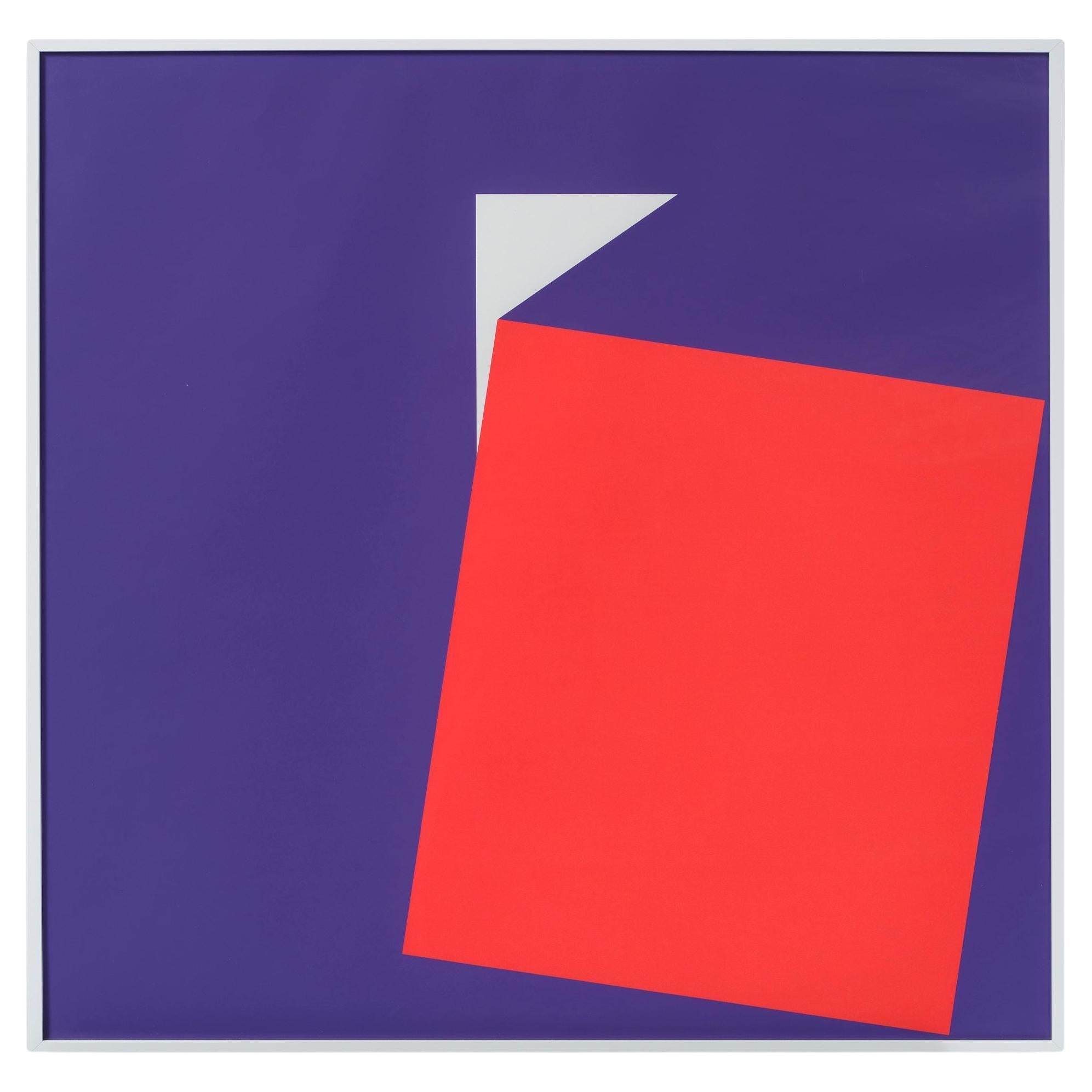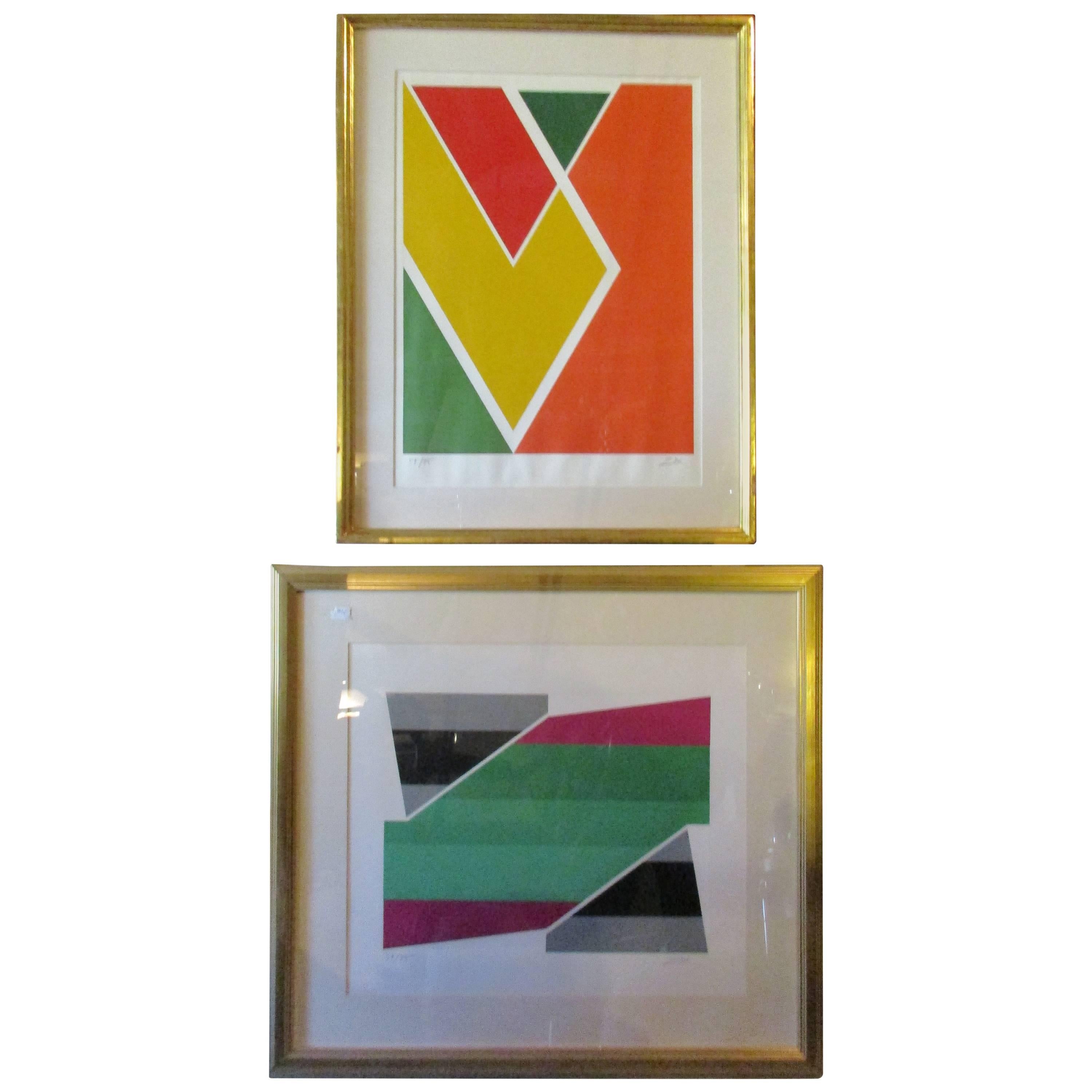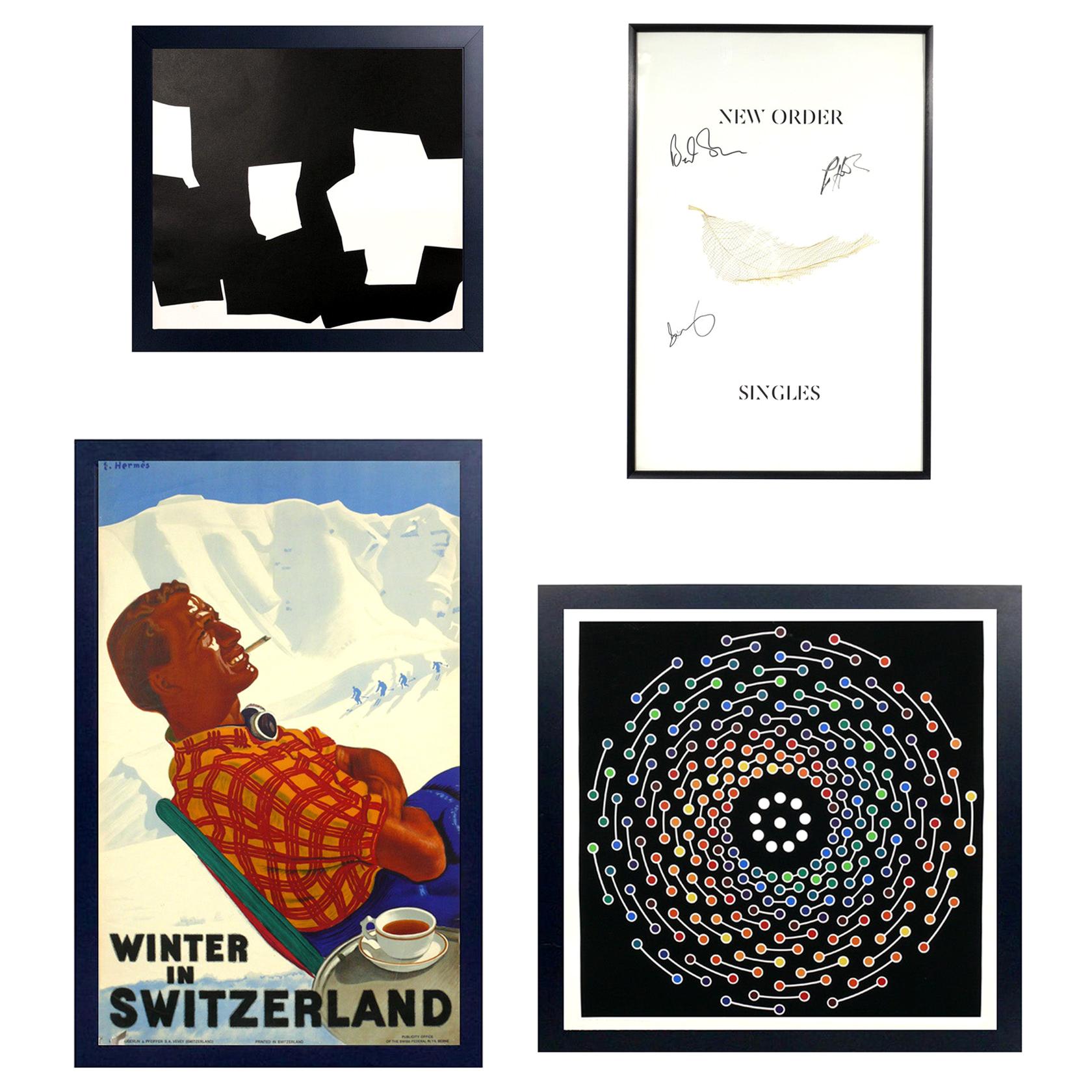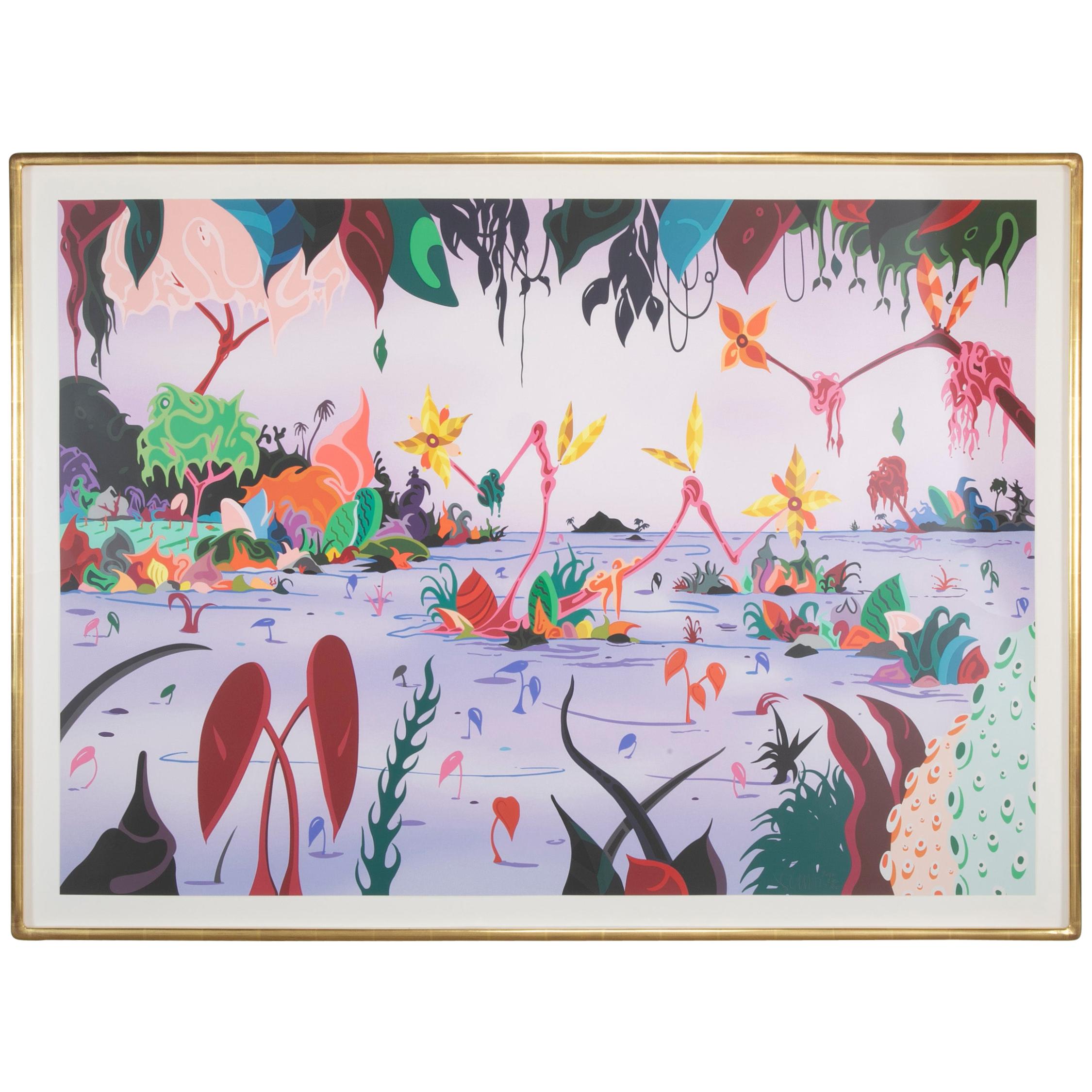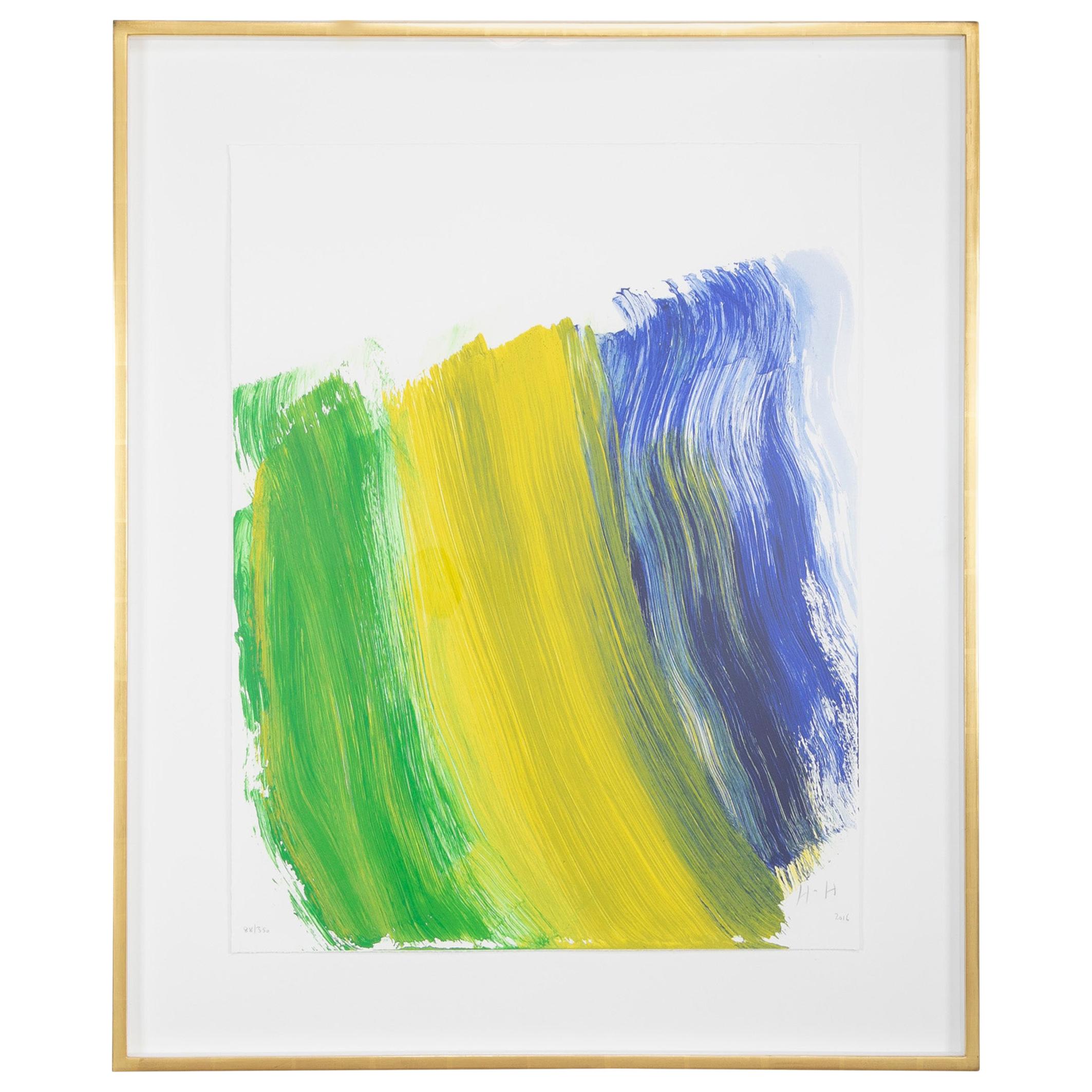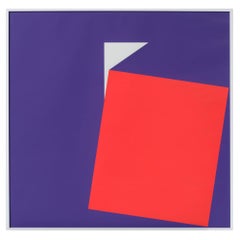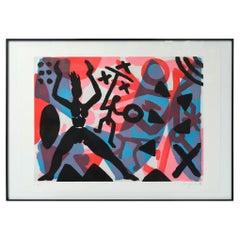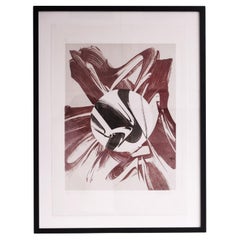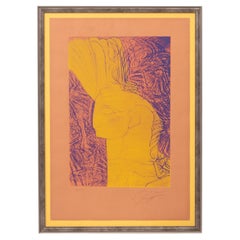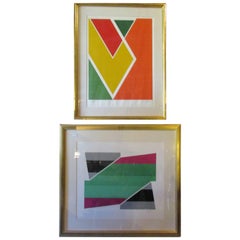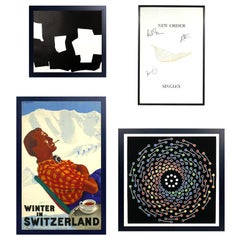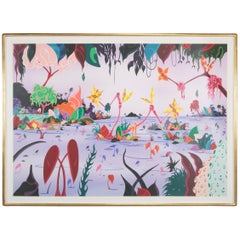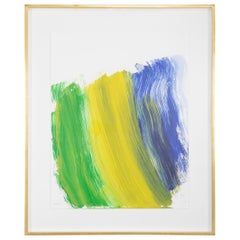Items Similar to Heinz Mack (*1931 Lollar) “untitled” Color silkscreen, 2013
Want more images or videos?
Request additional images or videos from the seller
1 of 6
Heinz Mack (*1931 Lollar) “untitled” Color silkscreen, 2013
About the Item
Heinz Mack (*1931 Lollar)
“untitled”
Created in 2013
Color silkscreen on wove paper, signed, numbered and dated by hand
EX. 31/70
framed behind museum glass
Dimensions:
Sheet size 65 x 80 cm
Frame size 81 x 95 cm
The painter, graphic artist and sculptor Heinz Mack is one of the main representatives of Kinetic Art in Germany and is best known for his “light reliefs” and “light installations”. After his early Tachist work, he found completely new means of expression at the end of the 1950s. Light and movement now became the central theme of his abstract paintings and sculptures, incorporating space and time. He repeatedly experimented with color and form, with serial structures and various materials. From 1960 onwards, he developed “light reliefs” and “light cubes” as well as the “light rotors” moved by motors.
After 1963, he increasingly concentrated on light-kinetic sculptures. Since the 1980s, he has also designed numerous public spaces. In 1989, he set up a studio in Ibiza. After almost three decades, he returned to painting and created the large-format “Chromatic Constellations”.
Mack studied art education at the Academy in Düsseldorf from 1950 to 1953 and then philosophy at the University of Cologne until 1956. Together with Otto Piene, he founded the group ZERO (“Zero Point of Art”) in 1957. The artists, who were joined by Günther Uecker in 1961, worked closely together until 1966. Mack worked in New York from 1964 to 1966. Early on, he took part in important exhibitions such as documenta 2 and 3 in 1959 and 1964 and the XXXV Venice Biennale in 1970. From 1969 to 1992, he was a member of the Academy of Arts in Berlin. He also received teaching assignments in Osaka (1970) and Toronto (1978), among others.
- Dimensions:Height: 19.69 in (50 cm)Width: 31.5 in (80 cm)Depth: 1.19 in (3 cm)
- Style:Modern (Of the Period)
- Materials and Techniques:
- Place of Origin:
- Period:
- Date of Manufacture:2013
- Condition:Wear consistent with age and use.
- Seller Location:Münster, DE
- Reference Number:1stDibs: LU9172244229482
About the Seller
5.0
Recognized Seller
These prestigious sellers are industry leaders and represent the highest echelon for item quality and design.
Established in 2000
1stDibs seller since 2023
- ShippingRetrieving quote...Shipping from: Münster, Germany
- Return Policy
Authenticity Guarantee
In the unlikely event there’s an issue with an item’s authenticity, contact us within 1 year for a full refund. DetailsMoney-Back Guarantee
If your item is not as described, is damaged in transit, or does not arrive, contact us within 7 days for a full refund. Details24-Hour Cancellation
You have a 24-hour grace period in which to reconsider your purchase, with no questions asked.Vetted Professional Sellers
Our world-class sellers must adhere to strict standards for service and quality, maintaining the integrity of our listings.Price-Match Guarantee
If you find that a seller listed the same item for a lower price elsewhere, we’ll match it.Trusted Global Delivery
Our best-in-class carrier network provides specialized shipping options worldwide, including custom delivery.More From This Seller
View AllGeorg Karl Pfahler “untitled” Color silkscreen on wove paper 1989
Located in Münster, DE
Georg Karl Pfahler (1926 - 2002)
“untitled”
Color silkscreen on wove paper, versa signed, numbered and dated by hand
Creation 1989
EX. 23/50
framed behind glass
Dimensions:
70 x 70 cm
Georg Karl Pfahler is considered the only important representative of the Hard Edge in Germany; he was a guest at the Biennales in Venice and São Paolo, taught in Nuremberg and Salzburg and was awarded numerous prizes.
Georg Karl Pfahler was born on October 8, 1926 in Emetzheim, Bavaria. He spent his childhood and youth on his parents' farm, far away from any art. Nevertheless, he loved painting and drawing from an early age and cultivated it intensively as a childhood pastime. However, Georg Karl Pfahler only received the impetus to study art in 1948 when he met students from the Nuremberg Art Academy and accepted their invitation. His parents, good but simple country folk, had no interest in their son's newly awakened passion, and the young man was also met with incomprehension in his home village. However, Georg Karl Pfahler did not let this put him off, but attended the Academy of Fine Arts in Nuremberg for two years, where he came into contact with original art for the first time and became acquainted with the works of Marc Chagall and Paul Klee. After two semesters, he moved to Stuttgart to study under Willi Baumeister, Gerhard...
Category
Vintage 1980s German Modern Contemporary Art
Materials
Paint, Paper
A.R. Penck Color etching, “untitled”, 1990s
By A.R. Penck (Ralf Winkler)
Located in Münster, DE
A.R. Penck (1939 Dresden - 2017 Zurich)
Color etching, “untitled”, created in the 1990s, signed and numbered by hand, ed. 35, copy 32/35
Sheet size: 65.5 x 89.5 cm
Frame size: ...
Category
1990s German Modern Contemporary Art
Materials
Paint, Paper
Karl Otto Götz color lithograph untitled 1967
Located in Münster, DE
Karl Otto Götz color lithograph
1.450,00 € incl. VAT
Karl Otto Götz (1914 Aachen - 2017 Wolfenacker)
Color lithograph "untitled", signed and dated, created 1967, framed behind glass
...
Category
Vintage 1960s German Modern Contemporary Art
Materials
Paper
Ernst Fuchs (1930 - 2015) "Head of a cherub", created in 1982 Color silkscreen
By Ernst Fuchs
Located in Münster, DE
Ernst Fuchs (1930 - 2015)
"Head of a cherub", created in 1982
Color silkscreen, ed. 200 pieces, signed and numbered
Dimensions 67.7 cm x 45 cm
Ernst Fuchs was born on February 13, 1930 in Vienna Ottakring as the only child of Maximilian and Leopoldine Fuchs; his father was of Jewish descent, which is why his grandfather and father emigrated to the USA and Shanghai in 1938 after the annexation of Austria by the Third Reich. To protect little Ernst from anti-Semitic hostility, it was decided to baptize him according to the Roman Catholic rite in 1942. The 12-year-old Ernst Fuchs was allowed to choose his own baptismal name and chose Ernst Peter Paul, in honor of the painter Peter Paul Rubens, whom he admired at the time. Around the same time, his godmother's brother, the painter and restorer Alois Schiemann, taught him the basics of drawing and painting. Until the age of 15, he attended the St. Anna painting school in Vienna, where he was taught sculpture and painting by Emmy Steinböck and Fritz Fröhlich.
After the war, Ernst Fuchs was finally able to take up his longed-for studies at the Academy of Fine Arts in Vienna, which he had previously been denied for racist reasons. His teachers were first Robin Andersen, then Albert Paris Gütersloh. While still a student, he was allowed to hold his first solo exhibition in Paris in 1949, and soon afterwards, in 1950, he also moved to the French capital. Ernst Fuchst traveled through Europe and the USA for six years before taking an extended stay at the Dormition Monastery on Mount Zion in Israel in 1957 to study icon painting in depth. He finally returned to Vienna in 1962, where he founded the Vienna School of Fantastic Realism with former fellow students, of which he himself was to become the most important representative. The early years in particular were characterized by a strong surrealism; mythical and religious symbols in particular appealed to Ernst Fuchs and permeated his work. Later, Fuchs turned increasingly to Mannerism.
Ernst Fuchs' artistic spectrum broadened over the years: he sang and recorded various albums, which, like the majority of his paintings, were inspired by mystical motifs, and he designed stage sets for such famous operas as Wagner's Parsifal and Lohengrin or Mozart's Die Zauberflöte. Ernst Fuchs also wrote philosophical treatises. He repeatedly collaborated with other artists, including the musicians Klaus Schulze...
Category
Vintage 1980s Austrian Modern Contemporary Art
Materials
Paper
Ernst Fuchs (1930 - 2015) "Head of a cherub", created in 1982 Color silkscreen
By Ernst Fuchs
Located in Münster, DE
Ernst Fuchs (1930 - 2015)
"Head of a cherub", created in 1982
Color silkscreen, ed. 200 pieces, signed and numbered
Dimensions 67.7 cm x 45 cm
Ernst Fuchs was born on February 13, 1930 in Vienna Ottakring as the only child of Maximilian and Leopoldine Fuchs; his father was of Jewish descent, which is why his grandfather and father emigrated to the USA and Shanghai in 1938 after the annexation of Austria by the Third Reich. To protect little Ernst from anti-Semitic hostility, it was decided to baptize him according to the Roman Catholic rite in 1942. The 12-year-old Ernst Fuchs was allowed to choose his own baptismal name and chose Ernst Peter Paul, in honor of the painter Peter Paul Rubens, whom he admired at the time. Around the same time, his godmother's brother, the painter and restorer Alois Schiemann, taught him the basics of drawing and painting. Until the age of 15, he attended the St. Anna painting school in Vienna, where he was taught sculpture and painting by Emmy Steinböck and Fritz Fröhlich.
After the war, Ernst Fuchs was finally able to take up his longed-for studies at the Academy of Fine Arts in Vienna, which he had previously been denied for racist reasons. His teachers were first Robin Andersen, then Albert Paris Gütersloh. While still a student, he was allowed to hold his first solo exhibition in Paris in 1949, and soon afterwards, in 1950, he also moved to the French capital. Ernst Fuchst traveled through Europe and the USA for six years before taking an extended stay at the Dormition Monastery on Mount Zion in Israel in 1957 to study icon painting in depth. He finally returned to Vienna in 1962, where he founded the Vienna School of Fantastic Realism with former fellow students, of which he himself was to become the most important representative. The early years in particular were characterized by a strong surrealism; mythical and religious symbols in particular appealed to Ernst Fuchs and permeated his work. Later, Fuchs turned increasingly to Mannerism.
Ernst Fuchs' artistic spectrum broadened over the years: he sang and recorded various albums, which, like the majority of his paintings, were inspired by mystical motifs, and he designed stage sets for such famous operas as Wagner's Parsifal and Lohengrin or Mozart's Die Zauberflöte. Ernst Fuchs also wrote philosophical treatises. He repeatedly collaborated with other artists, including the musicians Klaus Schulze...
Category
Vintage 1980s Austrian Modern Contemporary Art
Materials
Paper
Gerhard Uhlig Watercolor “untitled”, created in 1984
Located in Münster, DE
Gerhard Uhlig (1926-2015)
Watercolor “untitled”, created in 1984, signed and dated by hand, framed behind glass
Dimensions:
Frame size: 43 x 34 cm
Sheet size: 15 x 10 cm
Gerha...
Category
Vintage 1980s German Modern Contemporary Art
Materials
Paint, Paper
You May Also Like
Larry Zox Untitled Pair of 1970s Silkscreens
By Larry Zox
Located in Water Mill, NY
Pair of Larry Zox silksceens signed and each numbered 54/75 giltwood frames
size of top silkscreen H 28.75 x W24 x W 1.5.
Category
Vintage 1970s American Contemporary Art
$1,600 / item
Selection of Color Modern Lithographs and Silkscreens
Located in Atlanta, GA
Selection of color modern lithographs and silkscreens, circa 1930s-2000s. They have been framed in clean lined black lacquer gallery frames under UV resistant glass. They are:
Top row, left to right:
1) Black and white abstract lithograph by Eduardo Chillida, circa 1960s. It measures: 21.25" H x 23.25" W.
2) Color silkscreen New Order "Singles" poster, signed by three members of the band, circa 2005. It measures: 30.25" H x 20.25" W.
Bottom row, left to right:
3) Switzerland Ski Travel Color Silkscreen Poster, circa 1930s. It measures: 43" H x 27.75" W.
4) Abstract color lithograph, entitled "Spectral" by John...
Category
Vintage 1960s French Mid-Century Modern Prints
Materials
Glass, Wood, Paper
New Breed Bay A 72 Color Silkscreen by Erik Parker
By Erik Parker
Located in Stamford, CT
A72 color silkscreen on paper. Published by Pace Editions, Inc., New York 2017. Edition of 50. Signed, numbered and dated by the artist. Newly framed in a 23-karat yellow gold leaf f...
Category
2010s American Modern Contemporary Art
Materials
Paper
"Road To Rio", a 22 Color Silkscreen by Howard Hodgkin
By Howard Hodgkin
Located in Stamford, CT
A 2016 silkscreen print made on the occasion of the Rio Olympics titled "Road To Rio" by Howard Hodgkin. Numbered 88/350 signed H.H. and dated 2016 in pen...
Category
2010s English Modern Contemporary Art
Materials
Paper
R.B. Kitaj, Portrait, 13/70 Color Silkscreen 1970-1974
By Ronald Brooks Kitaj
Located in San Francisco, CA
ABOUT
R.B. Kitaj, Portrait, Edition of 70, Color silkscreen. Signed and numbered 13/70 in pencil upper right. Unframed.
CREATOR R.B. Kitaj, United Kingdom and USA.
DATE O...
Category
Mid-20th Century British Folk Art Contemporary Art
Materials
Paper
Josef Albers Silkscreen
By Josef Albers
Located in Stamford, CT
Josef Albers from Formulation: Articulation, 1972. Silkscreen prints, Folio II / Folder 6 . Floated in 12 karat white gold gilt frame using all acid free archival materials. #176 of ...
Category
Vintage 1970s American Modern Contemporary Art
Materials
Paper
$1,950
